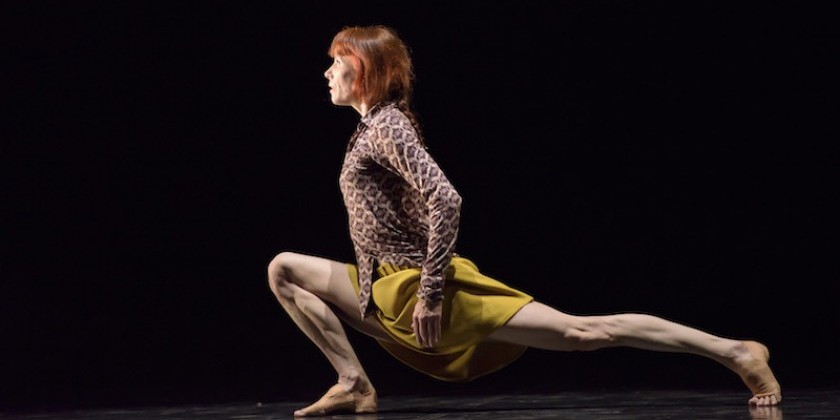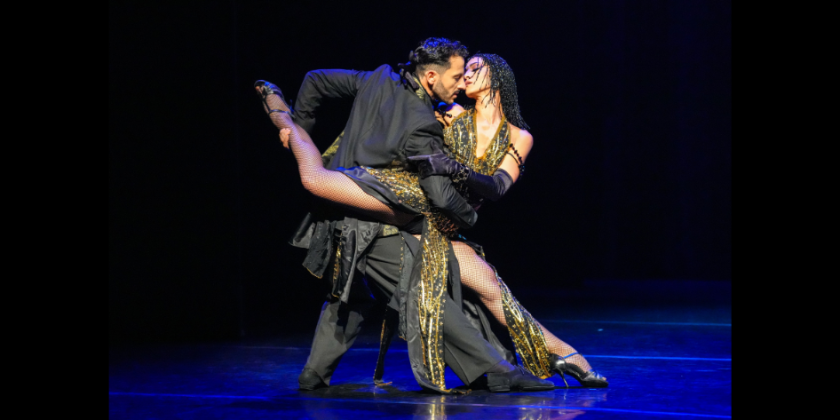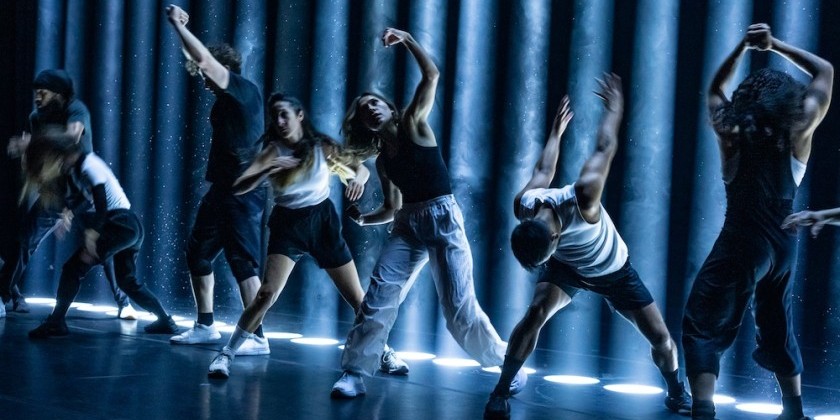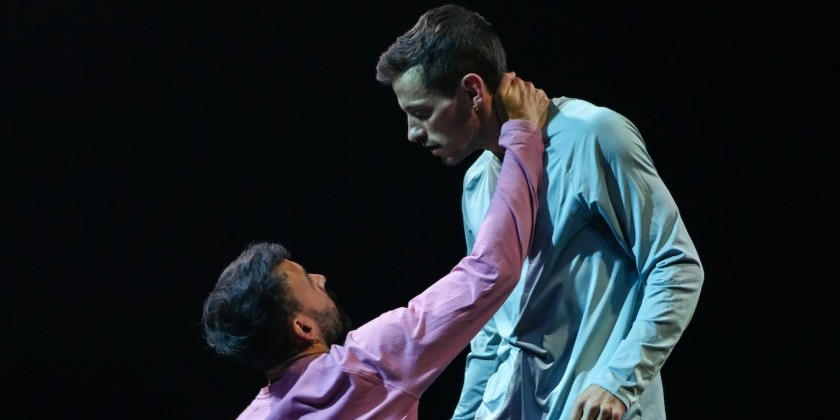Impressions of "Sylvie Guillem - Life in Progress"

The International Star in a Farewell Performance
Inspired by New York City Center presents SYLVIE GUILLEM LIFE IN PROGRESS (A Sadler’s Wells London Production)
November 12 – 14, 2015 at 8:00pm (watched Friday, November 13)
The dancer Sylvie Guillem made a stop at New York City Center on her farewell world tour with three performances, November 12 – 14. She chose the works of four contemporary choreographers with whom she has been associated for a good part of her illustrious career.
Writing about Guillem, I cannot help but think of one afternoon in my hometown in Germany in the mid-eighties, when a ballet teacher broke into tears. She had spent a weekend in Paris and had witnessed the young rising star. The experience was so profound that the world of ballet changed for my teacher as it did for the rest of the globe. In 1987, the year that Guillem along with fellow dancers Isabelle Guérin, Laurent Hilaire and Manuel Legris rewrote ballet history with William Forsythe’s In the Middle, Somewhat Elevated in Paris, I finally got to see her. That May, she (and I) performed at the Nijinsky Gala in Hamburg. I had been picked by Béjart’s ballet master to be one of the boys in Boléro (with Jorge Donn as the soloist on the table – a role that she later inherited) and Guillem performed the pas de deux from Don Quixote with Eric Vu-An as well as Movement, Rhythme, Étude, a pas de deux that Béjart had created for the two of them. It might have been another thirteen years until the new millennium, but she transported all of us in the audience and onstage watching from the wings into a bright new future. Her control, her flexibility, her vivaciousness and her sang-froid made her this planet’s reigning ballerina, a fact that was recognized when she received the 2001 inaugural Nijinsky Prize in Monaco.
Exposed to contemporary choreographers at an early age during her tenure at the Paris Opera Ballet by then artistic director Rudolf Nureyev, she proved that she was equally at home in classical, neo-classical and contemporary techniques. She simply was an all-around dancer. No one had climbed through the ranks at The Paris Opera Ballet as quickly before and when Nureyev appointed her to étoile at the age of nineteen in December 1984, it was evident that a new category of dancer had arrived. She was one of the few superstars, who had not escaped the iron curtain; but she needed to free herself from the confines of the organization that (and the paternal figure who) reared her. She left Paris to become an international guest artist with a new home base at The Royal Ballet in London, where the company created the position of Principal Guest Artist for her.
Her Parisian onstage partnership with Nureyev had been short-lived and unbalanced, yet it was important for introducing a new talent while an old one bid farewell. At The Royal Ballet, she devoured her partners. No male dancer was tall enough, nor did anyone possess the technical prowess or charisma to be able to develop a lasting and meaningful onstage partnership with Guillem. A young dancer back in Paris came closest to being a contender. Yet because Guillem was at home in different companies, her alliance with Nicolas Le Riche was not allowed to blossom fully. (To honor what could have been, Guillem danced with Le Riche at his farewell gala last year at Palais Garnier in Mats Ek’s Appartement) The lack of an onstage partnership that would have elevated her own dancing to an unimaginable realm might have served as the catalyst for her constant search for new material. Guillem blazed through the classics with enormous success, but her hunger for new challenges made her a chameleon of the dance world; and she got to inhabit an encyclopedia of different techniques and styles.

Guillem’s comprehensive approach gave contemporary choreographers the chance to work with the most able body in the business and elevated and propelled the dance field as a whole. She was no ballerina who after hanging up her pointe shoes would try her luck at modern dance and do vanity projects. Her artistry and curiosity made the transition from world’s greatest ballerina to world’s greatest dancer a seamless one.
On Friday night at City Center she displayed and shared her unique gift in the works of Akram Khan, Russell Maliphant and Mats Ek. Choreographer William Forsythe - who had been so instrumental early in her career – was represented by Duo 2015, a work for two men (Riley Watts and Brigel Gjoka), who skillfully and purposefully sent currents of energy moving through their bodies finally allowing them to envelop the space. Guillem opened the program in Khan’s Technê as an insect-like creature. Her articulation of each body part was clearly defined yet fluid and she became a servant to the exploration of movement. The body took over and made the experience as detailed as it was visceral. I felt as if I were witnessing a fascinating science project with a Nobel-Prize winning scientist at the helm. It was important. It had purpose. Here the dancer - as synergist and accomplice to the science of movement exploration - turned awkward motion into dance. Aristotle refers to “technê” as knowledge stemming from practice. The set piece of a silver-white wire tree in the middle of the stage is the suggested place of respite for this creature. She ends not quite certain if the time for rest has come. It was a quiet yet satisfying introduction to the beauty and artistry of Guillem at 50.

After the intriguing Forsythe work, she returned in Here & After, a duet by Russell Maliphant, alongside Emanuela Montanari, a soloist with Milan’s La Scala Ballet. Aided by the imaginative score by the wonderful British composer Andy Cowton, the piece grew from somber sculptural beauty to light effortless waves of movement. Over time the female companionship that had been featured with motions executed side-by-side developed; and partnering elements that required trust and support took over. The repetitive rotation of limbs almost grew giddy to the sounds of yodeling. On a journey toward an intrinsically happy place, these two women fortunately allowed the audience to come along. After the terror attacks that happened in Paris that very day, the performance affirmed that art is capable of healing through beauty.
After intermission Guillem returned to the stage in Mats Ek’s solo Bye set to Beethoven’s second and final movement of his last piano sonata, opus 111. Guillem interacts cleverly between live and on-screen imagery of herself before she disappears into the screen and gets swallowed by a crowd. Even if Ek’s piece is not as momentous as Beethoven’s composition, Guillem’s farewell certainly is.
Thomas Mann has organist Kretschmar explicate in his “Dr. Faustus:” “It had happened that the sonata had come, in the second, enormous movement, to an end, an end without any return. And when he said 'the sonata', he meant not only this one in C minor, but the sonata in general, as a species, as traditional art-form; it itself was here at an end, brought to its end, it had fulfilled its destiny, resolved itself, it took leave - the gesture of farewell of the D G G motif, consoled by the C sharp, was a leave-taking in this sense too, great as the whole piece itself, the farewell of the sonata form.”

Guillem’s farewell is a leave-taking of a (mainly interpretive) dance artist who ruled, served and changed the dance field as no one else had done since her mentor, Rudolf Nureyev. To her many accolades she gets to add this year’s Praemium Imperiale; and the Society of London Theatre presented her with a Special Award at the Olivier Awards 2015.
I hope that she remains active in the field and becomes a mentor to other dance artists. Her performances are etched in the memories of all who had the good fortune to see her. Thankfully at least the latter half of her career has been documented widely and can be seen at one’s own discretion in endless reruns via the World Wide Web.
Share Your Audience Review. Your Words Are Valuable to Dance.
Are you going to see this show, or have you seen it? Share "your" review here on The Dance Enthusiast. Your words are valuable. They help artists, educate audiences, and support the dance field in general. There is no need to be a professional critic. Just click through to our Audience Review Section and you will have the option to write free-form, or answer our helpful Enthusiast Review Questionnaire, or if you feel creative, even write a haiku review. So join the conversation.















